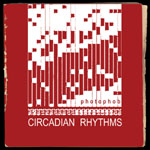
CD-R, Laridae, 2007
www.photophob.net
Photophob is the moniker adopted by Austrian Herwig Holzmann as an outlet for his specific brand of electronic music in a classic electronica vein. Listing influences such as Autechre, Aphex Twin, Arovane and Kettel, amongst many others, Holzmann’s music has an upbeat yet abstract quality set to playful synth lines that harks back to the early days of “intelligent dance music” and the heyday of labels like Rephlex and Warp. Showing the hallmarks of the fractured experimentalism of Autechre and the quirky yet slick breaks of Kettel, Holzmann also mixes in his own ambient elements to give his sound a different perspective.
Ranging from playful and slightly deranged breaks to broken beats and the introspective reflection of more ambient tracks, “Circadian Rhythms” covers several bases while maintaining the classic electronica imprint. This doesn’t mean that Holzmann is trying to replicate the classic electronic sound as – and it becomes more evident as the album progresses – he brings his own ideas and fuses the two together. Album opener “Circadian Rhythm (Cold Morning Yawning)” and “Plastic Fingers” for example are classic IDM tracks with crisp, precise breaks while “At the Dragon Lair Bus Stop” and “Old School Daemon Comes at Night” are slightly more abstract takes on the same theme. Where Holzmann’s influence really comes into play, however, is on the gently reflective “Daydreamer” where his ambient tendencies shine through, the glitchy breaks are toned down and a more rhythmic pace prevails. These tracks present an entirely more melancholic mood and are almost orchestral at times. Interestingly, “SRT Off” provides the bridge between “At the Dragon Lair Bus Stop” and “Daydreamer” by fusing quirky abstract beats with mellower tones. “Kite Fighter” and “WSL Waltz,” the latter having a brief outbreak of manic breaks, are similar in structure while “Run Last Ninja” sways more towards the MIDI scene with its simplistic computer game style electronics. “Death Lounge” appears as a trilogy, the first part being a short segue and the other two parts combined into a single track. What makes them interesting is the deep, dark jazz theme that is fused with some manic breaks.
Although “Circadian Rhythms” initially appears to be a homage to classic IDM, it soon takes a new direction when Holzmann introduces his own elements of floating ambience to counteract the clean, often frenetic and sometimes abstract breaks he utilises. Combining those breaks with classic synth lines only strengthens this impression, but Holzmann’s influence takes the album into new territory and adds a different perspective on a familiar format.
[7/10]
— Paul Lloyd
